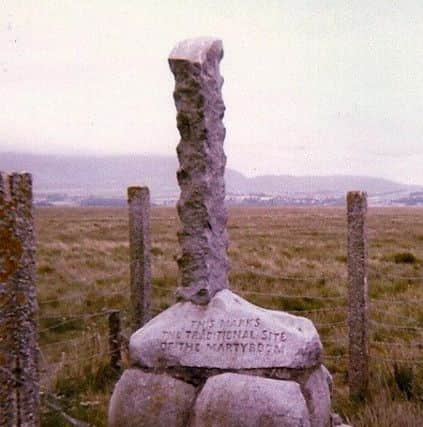The Wigtown Martyrs drowned for disobeying the king


The pair were drowned in a river just outside Wigtown in 1685, the Martyr’s Stake now marking the spot where they were tied up in the water and forced to wait for the tide to rise.
Both women were Covenanters and strict Presbyterians who were executed for refusing to swear an oath to James VII as head of the church.


Advertisement
Hide AdAdvertisement
Hide AdMargaret McLachlan was a widower, her late husband a carpenter, and a woman known for her piety.
Margaret Wilson, by contrast, was the daughter of a rich farmer from the Newton Stewart area who, along with her brother and sister, rejected their parents lead and worshipped with the Covenanters at illegal services held deep in the countryside.
The three children ended up living in the hills after their father, who did attend church, was forced to disown them by the authorities.


Both Margaret Wilson, her younger sister Agnes and Margaret McLachlan were eventually seized as the persecution of the Covenanters - known as the Killing Times - intensified in the south west of Scotland.
Advertisement
Hide AdAdvertisement
Hide AdThe three women may already have known each other before they were hauled into court, with some believing the two sisters had earlier sought shelter with Margaret McLachlan.
The Wilson sisters were thrown into the ‘thieves hole,’ a dungeon in Wigtown, before being taken to the local prison, where Margaret McLachlan was already incarcerated.
The three women appeared before the Justiciary Commission on April 13, 1685.
A fourth woman, Margaret Maxwell, 21, a servant in the home of a local noble, also came before the bench accused of “disorder”.
Advertisement
Hide AdAdvertisement
Hide AdShe was sentenced to a three-day public flogging but such was the disgust in the town, no one came to watch.
The Wilson sisters and Margaret McLachlan were charged with attending conventicles - essentially outdoor sermons - and house meetings.
They were also accused of attending the Battle of Bothwell Bridge, fought between Covenanters and government troops in June 1679, and Airds Moss, a fight to the death between Richard Cameron, a militant Presbyterian leader, his followers and a troop of Government soldiers the following year.
Margaret Wilson would have been only 12 at the time.
The women remained firm against their accusers. The refused to swear the Abjuration Oath to affirm allegiance to the King and renounce the Covenanters.
They also refused to kneel to receive their sentence.
Advertisement
Hide AdAdvertisement
Hide AdAgnes Wilson was released on £100 bail but Margaret Wilson and Margaret McLachlan were both sentenced to death.
They would be “tied to palisadoes and fixed in the sand within the flood mark, at the mouth of the Blednoch Stream, and there to stand till the flood flowed over them and drowned.”
Gilbert Wilson, father of Margaret, travelled to Edinburgh to appeal for his daughter’s release. Pleas were made to spare Margaret McLachlan on the grounds of her age.
The Privy Council agreed to overturn the sentences but the authorities in Galloway ignored the ruling.
Advertisement
Hide AdAdvertisement
Hide AdThe two women were tied to stakes in the Blednoch, which runs into Wigtown Bay, and it is said Margaret McLachlan was placed further into the water so that Wilson could watch her die.
The older woman’s throat was cut by a soldier as she fought for her life against the rising tide.
Last minute attempts from the shoreline to get Margaret Wilson to pledge her allegiance to the King failed. Her head was pushed below the water and her throat was also cut.
The bodies of the women were removed from the stakes and are buried in the Kirkyard at Wigtown, where a memorial stone has been placed for them.
Advertisement
Hide AdAdvertisement
Hide AdA memorial also stands to Margaret Wilson in the Old Town Cemetery in Stirling.
She was also depicted in the Millais painting, The Martyr of Solway, in 1871.
A memorial also stands in Wigtown to Covenanters William Johnston, John Milroy and George Walker who were all hanged in the same year as the two women were executed.
